Acute Care Transition Support Program: Respiratory Disorder Analysis
VerifiedAdded on 2023/06/08
|29
|6903
|192
Report
AI Summary
This report presents an analysis of an Acute Care Transition Support Program focused on respiratory disorders. It includes detailed nursing assessments for two patients, one with asthma and sleep disorder, and another with pneumonia. The assessments cover subjective and objective data, relevant pathophysiology, and potential contributing factors. The report also addresses the patients' knowledge of their conditions and provides insights into their social and environmental situations. Furthermore, it explores the pathophysiology of respiratory disorders, including the impact on various body systems such as neurological, cardiovascular, respiratory, gastrointestinal, genitourinary, musculoskeletal, integumentary, ophthalmology, and mental health. The report also includes an overview of COPD and its management. It offers a comprehensive overview of the program, emphasizing patient care and management strategies for respiratory disorders. The report is a contribution from a student on Desklib, a platform providing AI-based study tools.
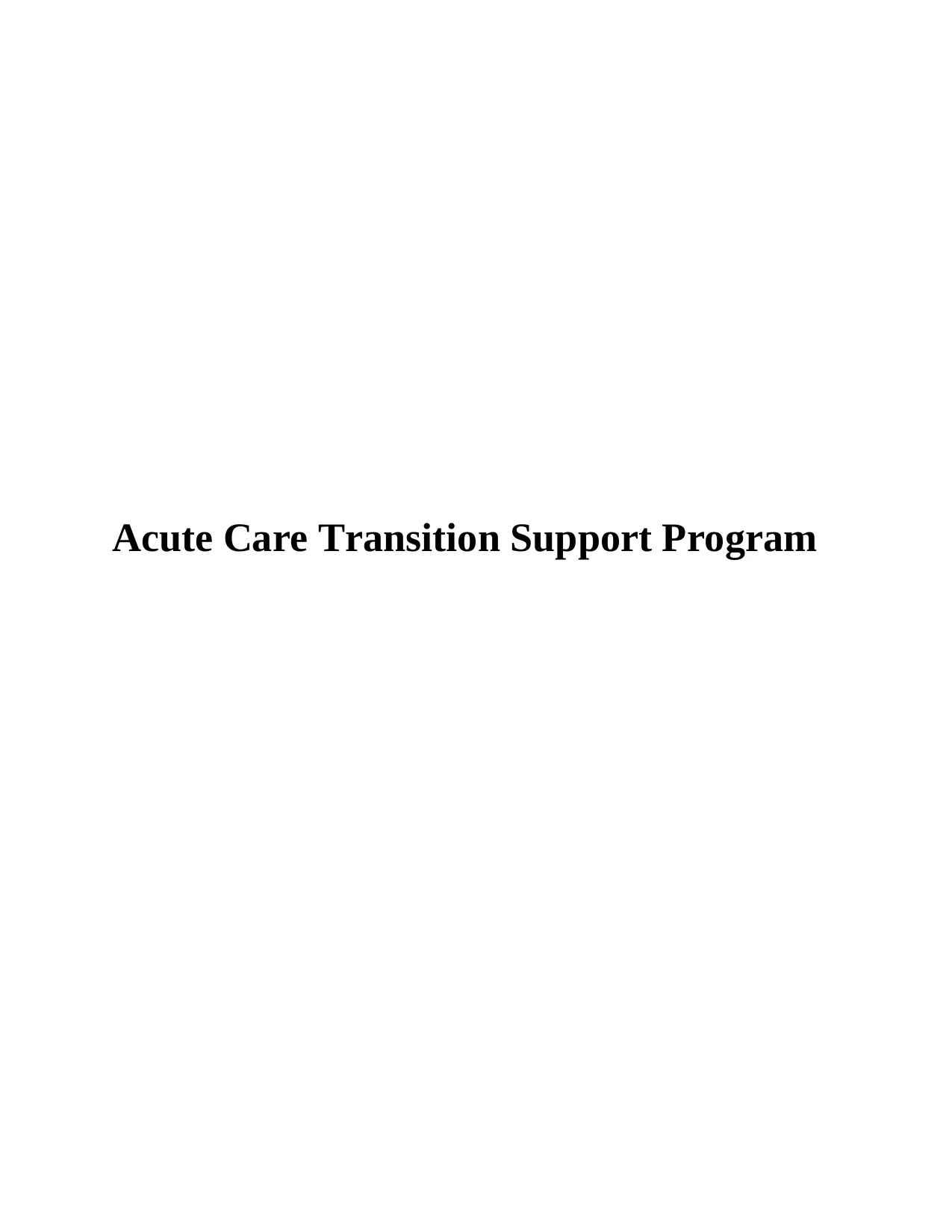
Acute Care Transition Support Program
Paraphrase This Document
Need a fresh take? Get an instant paraphrase of this document with our AI Paraphraser
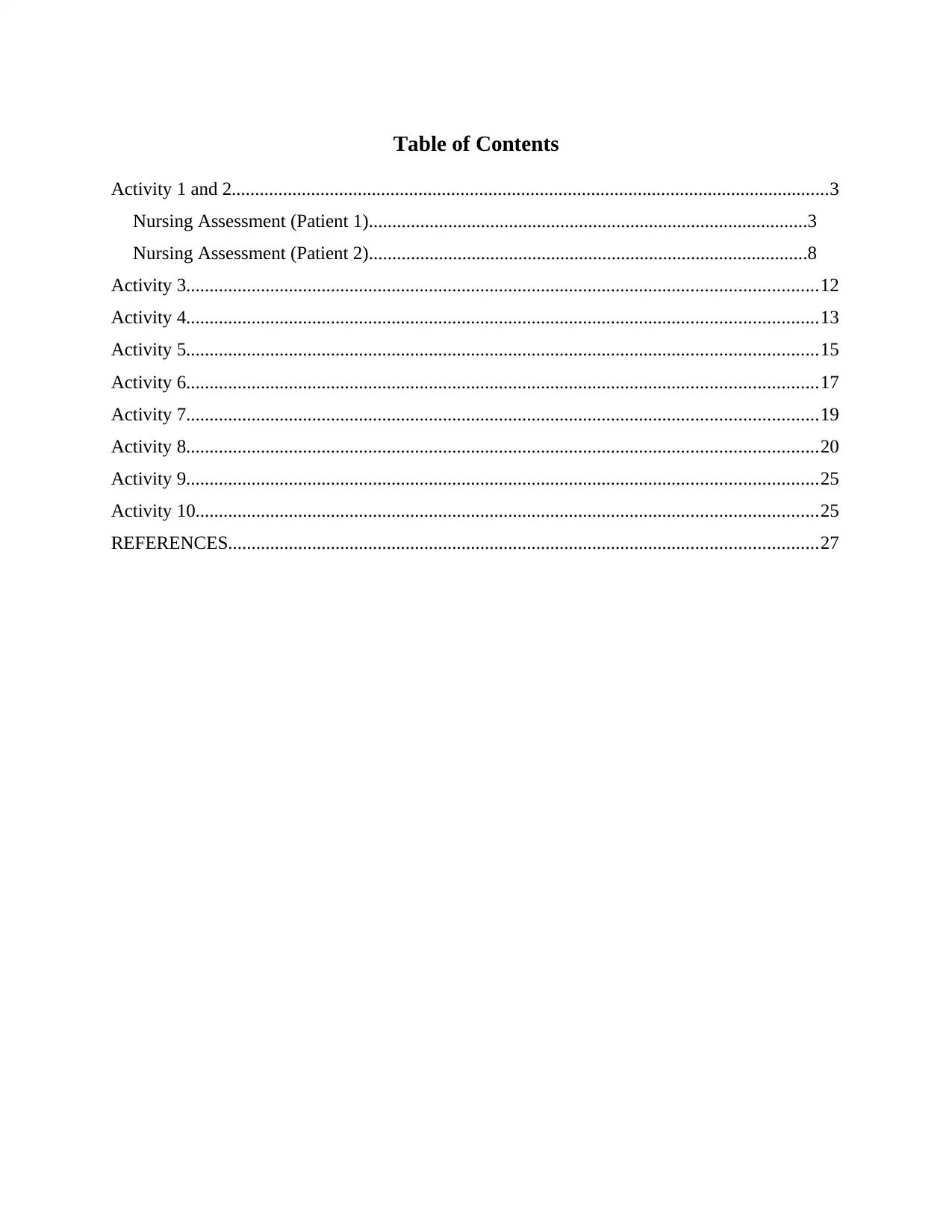
Table of Contents
Activity 1 and 2................................................................................................................................3
Nursing Assessment (Patient 1)..............................................................................................3
Nursing Assessment (Patient 2)..............................................................................................8
Activity 3.......................................................................................................................................12
Activity 4.......................................................................................................................................13
Activity 5.......................................................................................................................................15
Activity 6.......................................................................................................................................17
Activity 7.......................................................................................................................................19
Activity 8.......................................................................................................................................20
Activity 9.......................................................................................................................................25
Activity 10.....................................................................................................................................25
REFERENCES..............................................................................................................................27
Activity 1 and 2................................................................................................................................3
Nursing Assessment (Patient 1)..............................................................................................3
Nursing Assessment (Patient 2)..............................................................................................8
Activity 3.......................................................................................................................................12
Activity 4.......................................................................................................................................13
Activity 5.......................................................................................................................................15
Activity 6.......................................................................................................................................17
Activity 7.......................................................................................................................................19
Activity 8.......................................................................................................................................20
Activity 9.......................................................................................................................................25
Activity 10.....................................................................................................................................25
REFERENCES..............................................................................................................................27
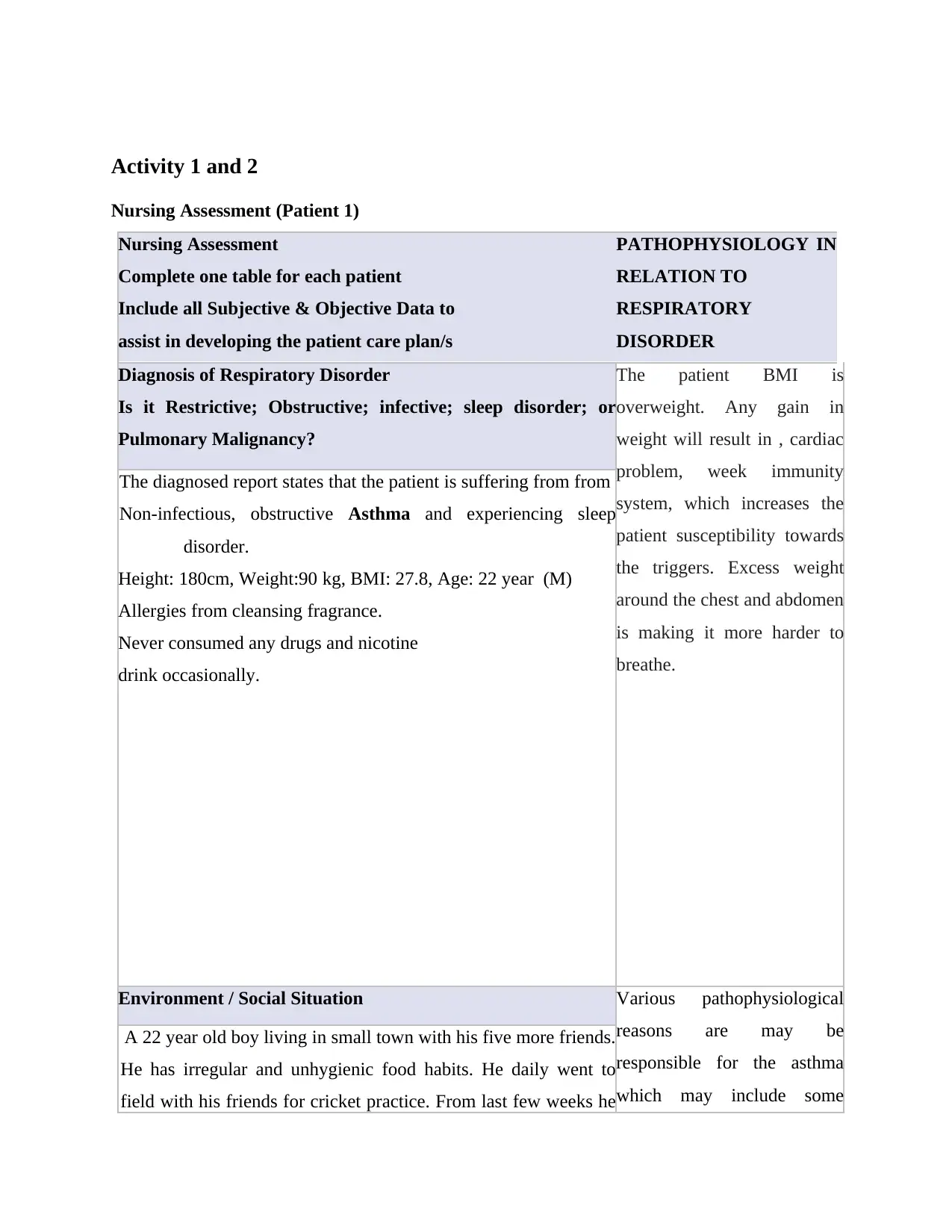
Activity 1 and 2
Nursing Assessment (Patient 1)
Nursing Assessment
Complete one table for each patient
Include all Subjective & Objective Data to
assist in developing the patient care plan/s
PATHOPHYSIOLOGY IN
RELATION TO
RESPIRATORY
DISORDER
Diagnosis of Respiratory Disorder
Is it Restrictive; Obstructive; infective; sleep disorder; or
Pulmonary Malignancy?
The patient BMI is
overweight. Any gain in
weight will result in , cardiac
problem, week immunity
system, which increases the
patient susceptibility towards
the triggers. Excess weight
around the chest and abdomen
is making it more harder to
breathe.
The diagnosed report states that the patient is suffering from from
Non-infectious, obstructive Asthma and experiencing sleep
disorder.
Height: 180cm, Weight:90 kg, BMI: 27.8, Age: 22 year (M)
Allergies from cleansing fragrance.
Never consumed any drugs and nicotine
drink occasionally.
Environment / Social Situation Various pathophysiological
reasons are may be
responsible for the asthma
which may include some
A 22 year old boy living in small town with his five more friends.
He has irregular and unhygienic food habits. He daily went to
field with his friends for cricket practice. From last few weeks he
Nursing Assessment (Patient 1)
Nursing Assessment
Complete one table for each patient
Include all Subjective & Objective Data to
assist in developing the patient care plan/s
PATHOPHYSIOLOGY IN
RELATION TO
RESPIRATORY
DISORDER
Diagnosis of Respiratory Disorder
Is it Restrictive; Obstructive; infective; sleep disorder; or
Pulmonary Malignancy?
The patient BMI is
overweight. Any gain in
weight will result in , cardiac
problem, week immunity
system, which increases the
patient susceptibility towards
the triggers. Excess weight
around the chest and abdomen
is making it more harder to
breathe.
The diagnosed report states that the patient is suffering from from
Non-infectious, obstructive Asthma and experiencing sleep
disorder.
Height: 180cm, Weight:90 kg, BMI: 27.8, Age: 22 year (M)
Allergies from cleansing fragrance.
Never consumed any drugs and nicotine
drink occasionally.
Environment / Social Situation Various pathophysiological
reasons are may be
responsible for the asthma
which may include some
A 22 year old boy living in small town with his five more friends.
He has irregular and unhygienic food habits. He daily went to
field with his friends for cricket practice. From last few weeks he
⊘ This is a preview!⊘
Do you want full access?
Subscribe today to unlock all pages.

Trusted by 1+ million students worldwide
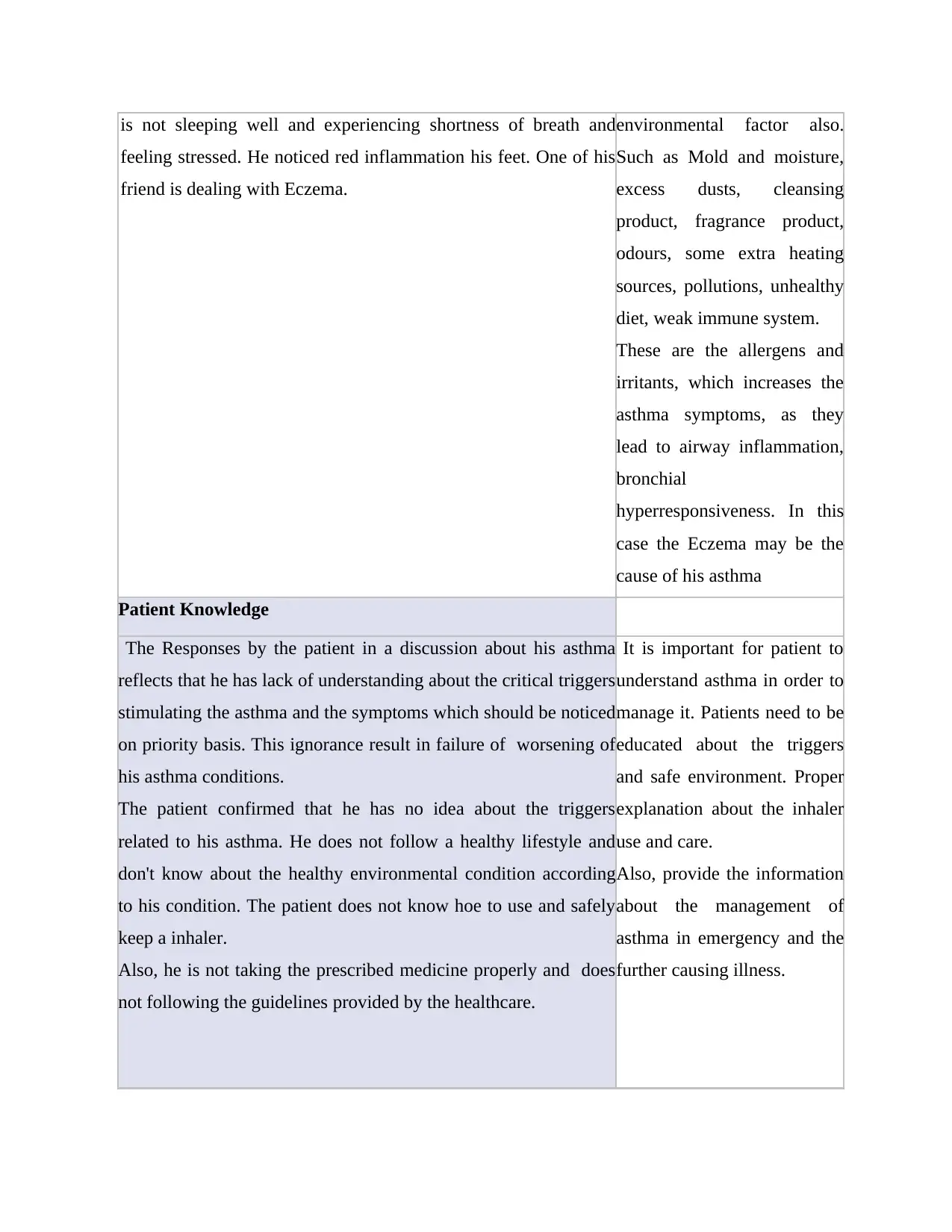
is not sleeping well and experiencing shortness of breath and
feeling stressed. He noticed red inflammation his feet. One of his
friend is dealing with Eczema.
environmental factor also.
Such as Mold and moisture,
excess dusts, cleansing
product, fragrance product,
odours, some extra heating
sources, pollutions, unhealthy
diet, weak immune system.
These are the allergens and
irritants, which increases the
asthma symptoms, as they
lead to airway inflammation,
bronchial
hyperresponsiveness. In this
case the Eczema may be the
cause of his asthma
Patient Knowledge
The Responses by the patient in a discussion about his asthma
reflects that he has lack of understanding about the critical triggers
stimulating the asthma and the symptoms which should be noticed
on priority basis. This ignorance result in failure of worsening of
his asthma conditions.
The patient confirmed that he has no idea about the triggers
related to his asthma. He does not follow a healthy lifestyle and
don't know about the healthy environmental condition according
to his condition. The patient does not know hoe to use and safely
keep a inhaler.
Also, he is not taking the prescribed medicine properly and does
not following the guidelines provided by the healthcare.
It is important for patient to
understand asthma in order to
manage it. Patients need to be
educated about the triggers
and safe environment. Proper
explanation about the inhaler
use and care.
Also, provide the information
about the management of
asthma in emergency and the
further causing illness.
feeling stressed. He noticed red inflammation his feet. One of his
friend is dealing with Eczema.
environmental factor also.
Such as Mold and moisture,
excess dusts, cleansing
product, fragrance product,
odours, some extra heating
sources, pollutions, unhealthy
diet, weak immune system.
These are the allergens and
irritants, which increases the
asthma symptoms, as they
lead to airway inflammation,
bronchial
hyperresponsiveness. In this
case the Eczema may be the
cause of his asthma
Patient Knowledge
The Responses by the patient in a discussion about his asthma
reflects that he has lack of understanding about the critical triggers
stimulating the asthma and the symptoms which should be noticed
on priority basis. This ignorance result in failure of worsening of
his asthma conditions.
The patient confirmed that he has no idea about the triggers
related to his asthma. He does not follow a healthy lifestyle and
don't know about the healthy environmental condition according
to his condition. The patient does not know hoe to use and safely
keep a inhaler.
Also, he is not taking the prescribed medicine properly and does
not following the guidelines provided by the healthcare.
It is important for patient to
understand asthma in order to
manage it. Patients need to be
educated about the triggers
and safe environment. Proper
explanation about the inhaler
use and care.
Also, provide the information
about the management of
asthma in emergency and the
further causing illness.
Paraphrase This Document
Need a fresh take? Get an instant paraphrase of this document with our AI Paraphraser

Nursing Assessment
Complete one table for each patient
Include all Subjective & Objective
Data to assist in developing the patient care plan/s
SIOLO
R
PATHOPHYSIOLOGY IN
RELATION TO
RESPIRATORY
DISORDER
Neurological/Peripheral & Central Nervous system Inflammation in air ways affects
neuronal activity including
sensory nerves and synaptic
transmission within autonomic
ganglia.
Asthma affect neural activity, disturb neural reflex pathway
Cardiovascular / circulatory
Patient had a palpitation and on examination patient is found in
hypertension with blood pressure of 142/89. heart rate is found
120 bpm. Capillary refill time is more than 2 sec.
High Blood shows that lungs
are not able to pull in enough
amount of air then the heart will
pump at higher speed to get
enough oxygen , as a result
blood pressure will go up.
Prolonged capillary refill time
indicate peripheral perfusion.
(Eger and Bel, 2019).
Respiratory Inside wall of lungs airways
gets swollen and restrict the air
flow. The congestion and cough
along with wheezing suggest a
The patient has exhibited congested upper airway, cough and
wheeze. Shortness of breath with 38 breaths/ min. the oxygen
Complete one table for each patient
Include all Subjective & Objective
Data to assist in developing the patient care plan/s
SIOLO
R
PATHOPHYSIOLOGY IN
RELATION TO
RESPIRATORY
DISORDER
Neurological/Peripheral & Central Nervous system Inflammation in air ways affects
neuronal activity including
sensory nerves and synaptic
transmission within autonomic
ganglia.
Asthma affect neural activity, disturb neural reflex pathway
Cardiovascular / circulatory
Patient had a palpitation and on examination patient is found in
hypertension with blood pressure of 142/89. heart rate is found
120 bpm. Capillary refill time is more than 2 sec.
High Blood shows that lungs
are not able to pull in enough
amount of air then the heart will
pump at higher speed to get
enough oxygen , as a result
blood pressure will go up.
Prolonged capillary refill time
indicate peripheral perfusion.
(Eger and Bel, 2019).
Respiratory Inside wall of lungs airways
gets swollen and restrict the air
flow. The congestion and cough
along with wheezing suggest a
The patient has exhibited congested upper airway, cough and
wheeze. Shortness of breath with 38 breaths/ min. the oxygen
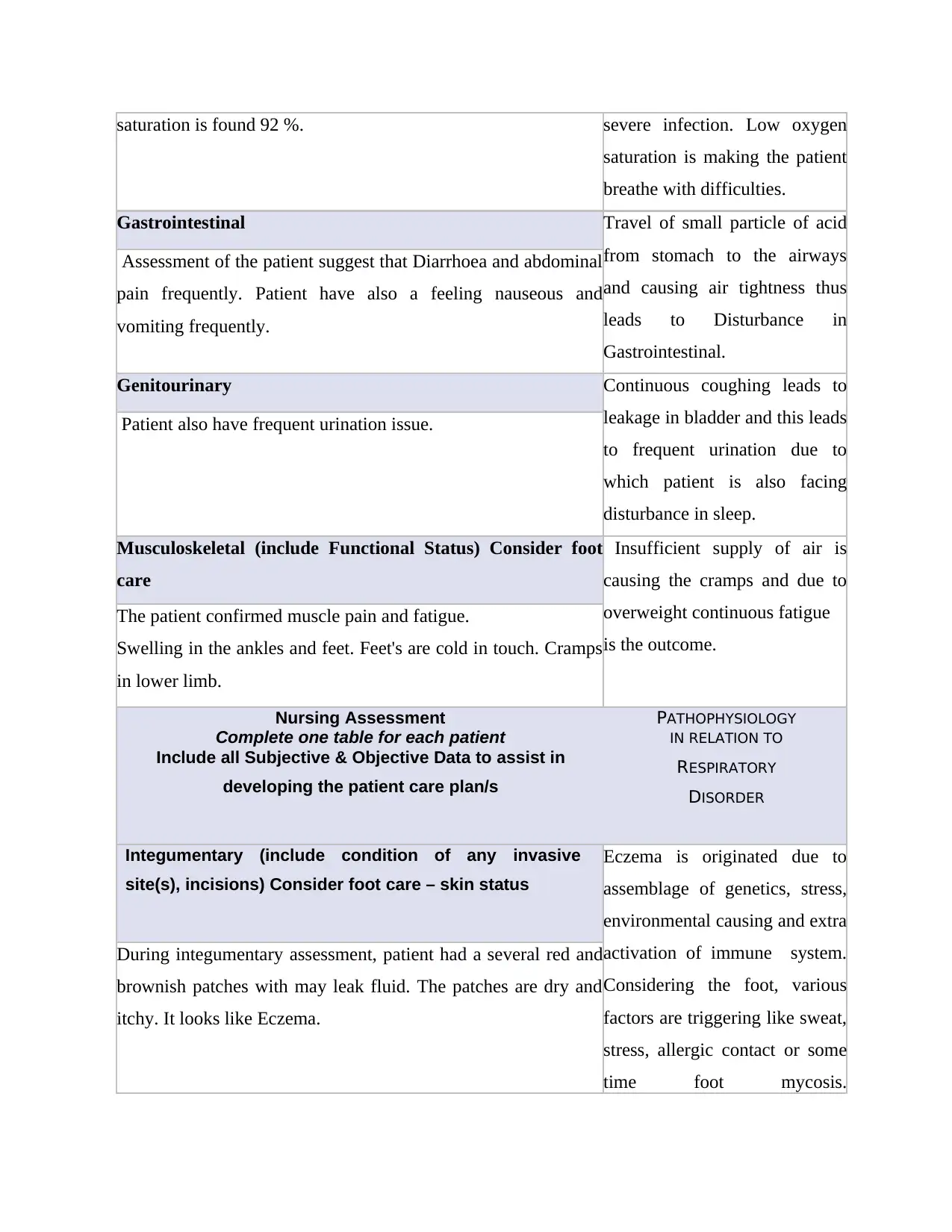
saturation is found 92 %. severe infection. Low oxygen
saturation is making the patient
breathe with difficulties.
Gastrointestinal Travel of small particle of acid
from stomach to the airways
and causing air tightness thus
leads to Disturbance in
Gastrointestinal.
Assessment of the patient suggest that Diarrhoea and abdominal
pain frequently. Patient have also a feeling nauseous and
vomiting frequently.
Genitourinary Continuous coughing leads to
leakage in bladder and this leads
to frequent urination due to
which patient is also facing
disturbance in sleep.
Patient also have frequent urination issue.
Musculoskeletal (include Functional Status) Consider foot
care
Insufficient supply of air is
causing the cramps and due to
overweight continuous fatigue
is the outcome.
The patient confirmed muscle pain and fatigue.
Swelling in the ankles and feet. Feet's are cold in touch. Cramps
in lower limb.
Nursing Assessment
Complete one table for each patient
Include all Subjective & Objective Data to assist in
developing the patient care plan/s
PATHOPHYSIOLOGY
IN RELATION TO
RESPIRATORY
DISORDER
Integumentary (include condition of any invasive
site(s), incisions) Consider foot care – skin status
Eczema is originated due to
assemblage of genetics, stress,
environmental causing and extra
activation of immune system.
Considering the foot, various
factors are triggering like sweat,
stress, allergic contact or some
time foot mycosis.
During integumentary assessment, patient had a several red and
brownish patches with may leak fluid. The patches are dry and
itchy. It looks like Eczema.
saturation is making the patient
breathe with difficulties.
Gastrointestinal Travel of small particle of acid
from stomach to the airways
and causing air tightness thus
leads to Disturbance in
Gastrointestinal.
Assessment of the patient suggest that Diarrhoea and abdominal
pain frequently. Patient have also a feeling nauseous and
vomiting frequently.
Genitourinary Continuous coughing leads to
leakage in bladder and this leads
to frequent urination due to
which patient is also facing
disturbance in sleep.
Patient also have frequent urination issue.
Musculoskeletal (include Functional Status) Consider foot
care
Insufficient supply of air is
causing the cramps and due to
overweight continuous fatigue
is the outcome.
The patient confirmed muscle pain and fatigue.
Swelling in the ankles and feet. Feet's are cold in touch. Cramps
in lower limb.
Nursing Assessment
Complete one table for each patient
Include all Subjective & Objective Data to assist in
developing the patient care plan/s
PATHOPHYSIOLOGY
IN RELATION TO
RESPIRATORY
DISORDER
Integumentary (include condition of any invasive
site(s), incisions) Consider foot care – skin status
Eczema is originated due to
assemblage of genetics, stress,
environmental causing and extra
activation of immune system.
Considering the foot, various
factors are triggering like sweat,
stress, allergic contact or some
time foot mycosis.
During integumentary assessment, patient had a several red and
brownish patches with may leak fluid. The patches are dry and
itchy. It looks like Eczema.
⊘ This is a preview!⊘
Do you want full access?
Subscribe today to unlock all pages.

Trusted by 1+ million students worldwide
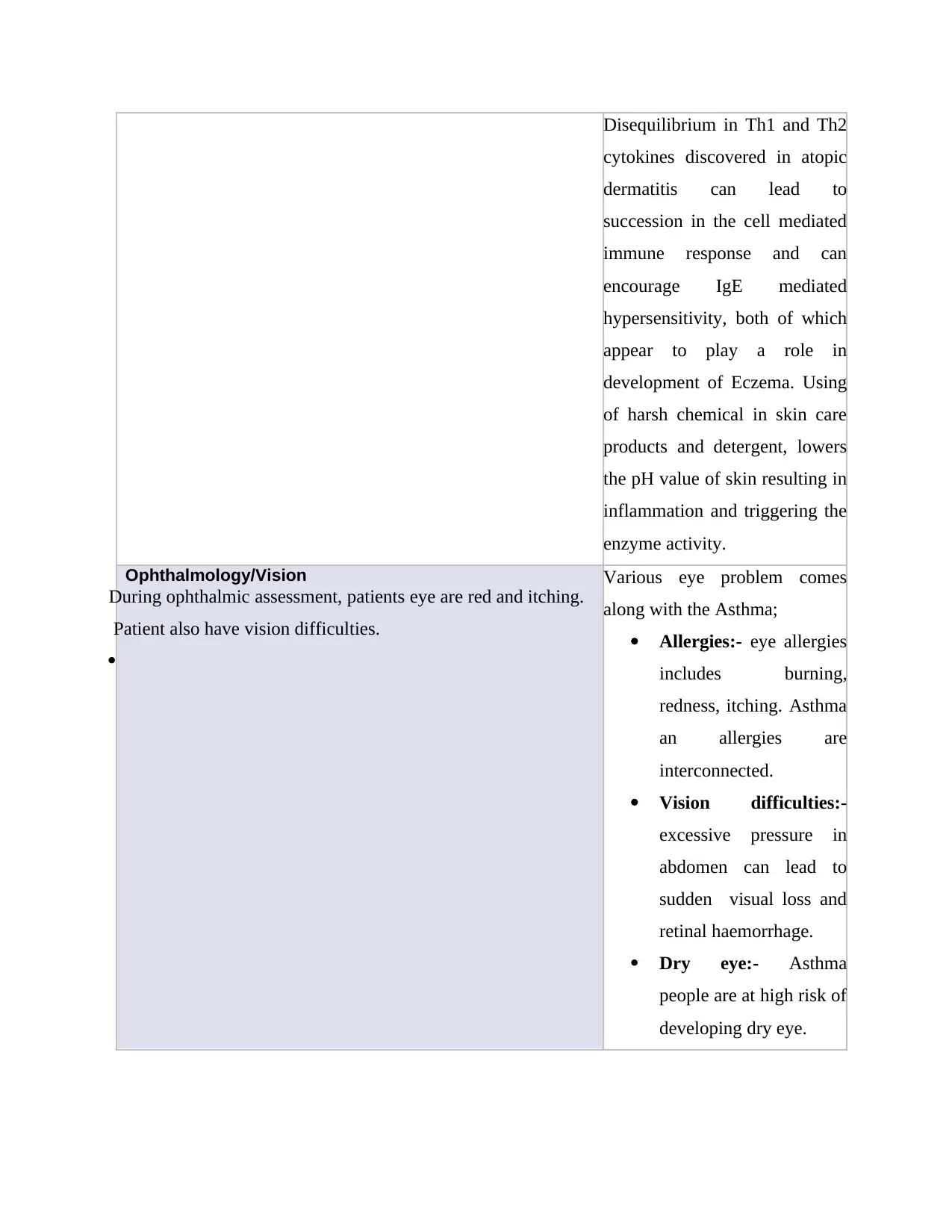
Disequilibrium in Th1 and Th2
cytokines discovered in atopic
dermatitis can lead to
succession in the cell mediated
immune response and can
encourage IgE mediated
hypersensitivity, both of which
appear to play a role in
development of Eczema. Using
of harsh chemical in skin care
products and detergent, lowers
the pH value of skin resulting in
inflammation and triggering the
enzyme activity.
Ophthalmology/Vision
During ophthalmic assessment, patients eye are red and itching.
Patient also have vision difficulties.
Various eye problem comes
along with the Asthma;
Allergies:- eye allergies
includes burning,
redness, itching. Asthma
an allergies are
interconnected.
Vision difficulties:-
excessive pressure in
abdomen can lead to
sudden visual loss and
retinal haemorrhage.
Dry eye:- Asthma
people are at high risk of
developing dry eye.
cytokines discovered in atopic
dermatitis can lead to
succession in the cell mediated
immune response and can
encourage IgE mediated
hypersensitivity, both of which
appear to play a role in
development of Eczema. Using
of harsh chemical in skin care
products and detergent, lowers
the pH value of skin resulting in
inflammation and triggering the
enzyme activity.
Ophthalmology/Vision
During ophthalmic assessment, patients eye are red and itching.
Patient also have vision difficulties.
Various eye problem comes
along with the Asthma;
Allergies:- eye allergies
includes burning,
redness, itching. Asthma
an allergies are
interconnected.
Vision difficulties:-
excessive pressure in
abdomen can lead to
sudden visual loss and
retinal haemorrhage.
Dry eye:- Asthma
people are at high risk of
developing dry eye.
Paraphrase This Document
Need a fresh take? Get an instant paraphrase of this document with our AI Paraphraser

Mental Health/Cognition Stress leads to inflammation making asthma
treatments more tough. Stress can lead to excess
secretion of histamine, which can lead to asthma
attack. Stress also weaken the immune system of
body thus making the body more susceptible to
asthma triggers. Stress can lead to muscles
constriction, that lead to tighter chest and some
other issues that may trigger asthma. This stress
will result in aggressiveness and further lead to
depression.
Patient wants to sleep and always feel drowsy.
Patient is always in stress and depression.
Patient behavior was also aggressive.
Other assessment findings /
considerations
No
Nursing Assessment (Patient 2)
Nursing Assessment
Complete one table for each patient
Include all Subjective & Objective Data to
assist in developing the patient care plan/s
PATHOPHYSIOLOGY IN
RELATION TO
RESPIRATORY
DISORDER
Diagnosis of Respiratory Disorder; Is it
Restrictive; Obstructive; infective; sleep disorder
Pulmonary Malignancy?
The diagnosed report suggests that the patient is suffering from
infectious, restrictive Pneumonia and experiencing sleep
The patient BMI is very low.
Any additional weight loss
leads to malnutrition, cardiac
issues and Asthmatic history
make him more susceptible to
treatments more tough. Stress can lead to excess
secretion of histamine, which can lead to asthma
attack. Stress also weaken the immune system of
body thus making the body more susceptible to
asthma triggers. Stress can lead to muscles
constriction, that lead to tighter chest and some
other issues that may trigger asthma. This stress
will result in aggressiveness and further lead to
depression.
Patient wants to sleep and always feel drowsy.
Patient is always in stress and depression.
Patient behavior was also aggressive.
Other assessment findings /
considerations
No
Nursing Assessment (Patient 2)
Nursing Assessment
Complete one table for each patient
Include all Subjective & Objective Data to
assist in developing the patient care plan/s
PATHOPHYSIOLOGY IN
RELATION TO
RESPIRATORY
DISORDER
Diagnosis of Respiratory Disorder; Is it
Restrictive; Obstructive; infective; sleep disorder
Pulmonary Malignancy?
The diagnosed report suggests that the patient is suffering from
infectious, restrictive Pneumonia and experiencing sleep
The patient BMI is very low.
Any additional weight loss
leads to malnutrition, cardiac
issues and Asthmatic history
make him more susceptible to
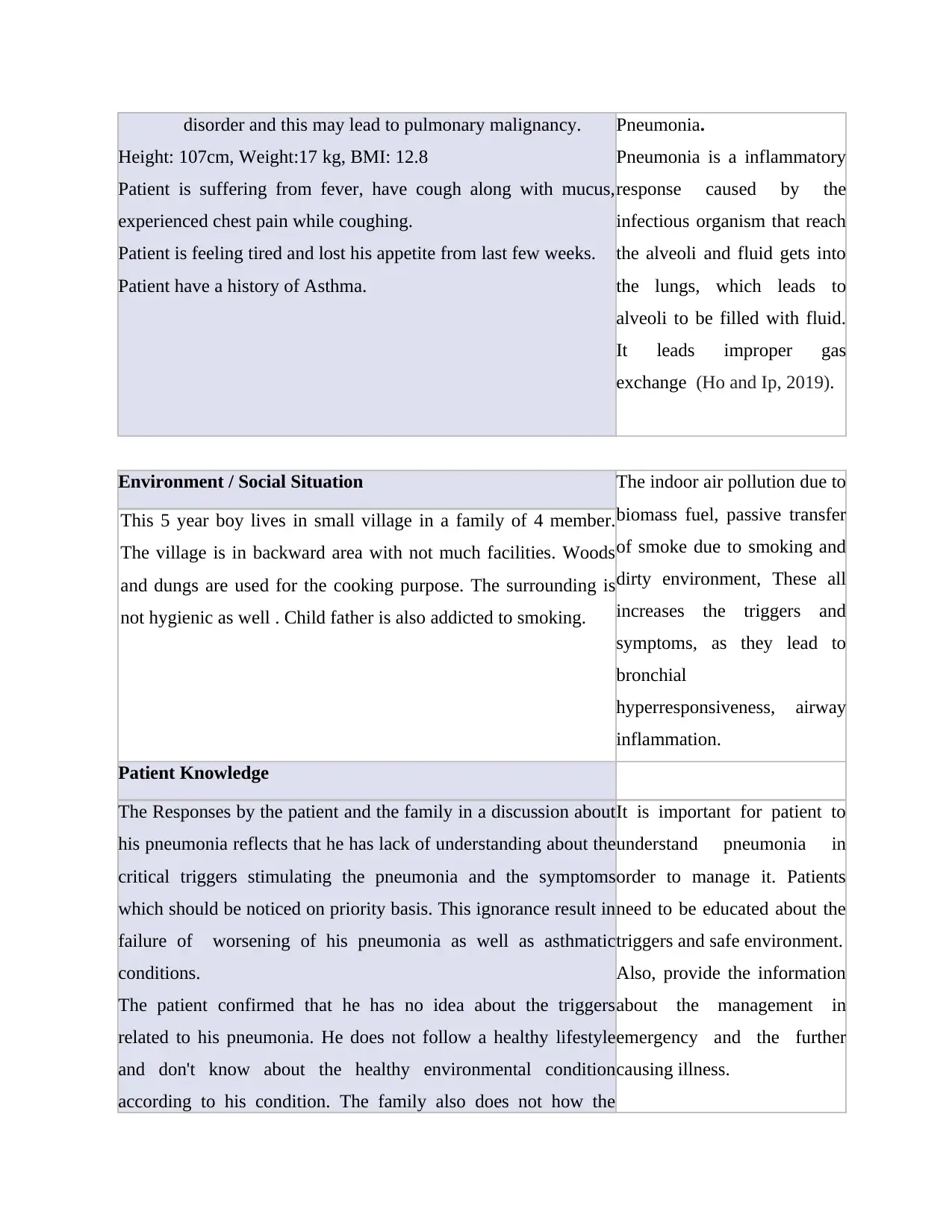
disorder and this may lead to pulmonary malignancy.
Height: 107cm, Weight:17 kg, BMI: 12.8
Patient is suffering from fever, have cough along with mucus,
experienced chest pain while coughing.
Patient is feeling tired and lost his appetite from last few weeks.
Patient have a history of Asthma.
Pneumonia.
Pneumonia is a inflammatory
response caused by the
infectious organism that reach
the alveoli and fluid gets into
the lungs, which leads to
alveoli to be filled with fluid.
It leads improper gas
exchange (Ho and Ip, 2019).
Environment / Social Situation The indoor air pollution due to
biomass fuel, passive transfer
of smoke due to smoking and
dirty environment, These all
increases the triggers and
symptoms, as they lead to
bronchial
hyperresponsiveness, airway
inflammation.
This 5 year boy lives in small village in a family of 4 member.
The village is in backward area with not much facilities. Woods
and dungs are used for the cooking purpose. The surrounding is
not hygienic as well . Child father is also addicted to smoking.
Patient Knowledge
The Responses by the patient and the family in a discussion about
his pneumonia reflects that he has lack of understanding about the
critical triggers stimulating the pneumonia and the symptoms
which should be noticed on priority basis. This ignorance result in
failure of worsening of his pneumonia as well as asthmatic
conditions.
The patient confirmed that he has no idea about the triggers
related to his pneumonia. He does not follow a healthy lifestyle
and don't know about the healthy environmental condition
according to his condition. The family also does not how the
It is important for patient to
understand pneumonia in
order to manage it. Patients
need to be educated about the
triggers and safe environment.
Also, provide the information
about the management in
emergency and the further
causing illness.
Height: 107cm, Weight:17 kg, BMI: 12.8
Patient is suffering from fever, have cough along with mucus,
experienced chest pain while coughing.
Patient is feeling tired and lost his appetite from last few weeks.
Patient have a history of Asthma.
Pneumonia.
Pneumonia is a inflammatory
response caused by the
infectious organism that reach
the alveoli and fluid gets into
the lungs, which leads to
alveoli to be filled with fluid.
It leads improper gas
exchange (Ho and Ip, 2019).
Environment / Social Situation The indoor air pollution due to
biomass fuel, passive transfer
of smoke due to smoking and
dirty environment, These all
increases the triggers and
symptoms, as they lead to
bronchial
hyperresponsiveness, airway
inflammation.
This 5 year boy lives in small village in a family of 4 member.
The village is in backward area with not much facilities. Woods
and dungs are used for the cooking purpose. The surrounding is
not hygienic as well . Child father is also addicted to smoking.
Patient Knowledge
The Responses by the patient and the family in a discussion about
his pneumonia reflects that he has lack of understanding about the
critical triggers stimulating the pneumonia and the symptoms
which should be noticed on priority basis. This ignorance result in
failure of worsening of his pneumonia as well as asthmatic
conditions.
The patient confirmed that he has no idea about the triggers
related to his pneumonia. He does not follow a healthy lifestyle
and don't know about the healthy environmental condition
according to his condition. The family also does not how the
It is important for patient to
understand pneumonia in
order to manage it. Patients
need to be educated about the
triggers and safe environment.
Also, provide the information
about the management in
emergency and the further
causing illness.
⊘ This is a preview!⊘
Do you want full access?
Subscribe today to unlock all pages.

Trusted by 1+ million students worldwide
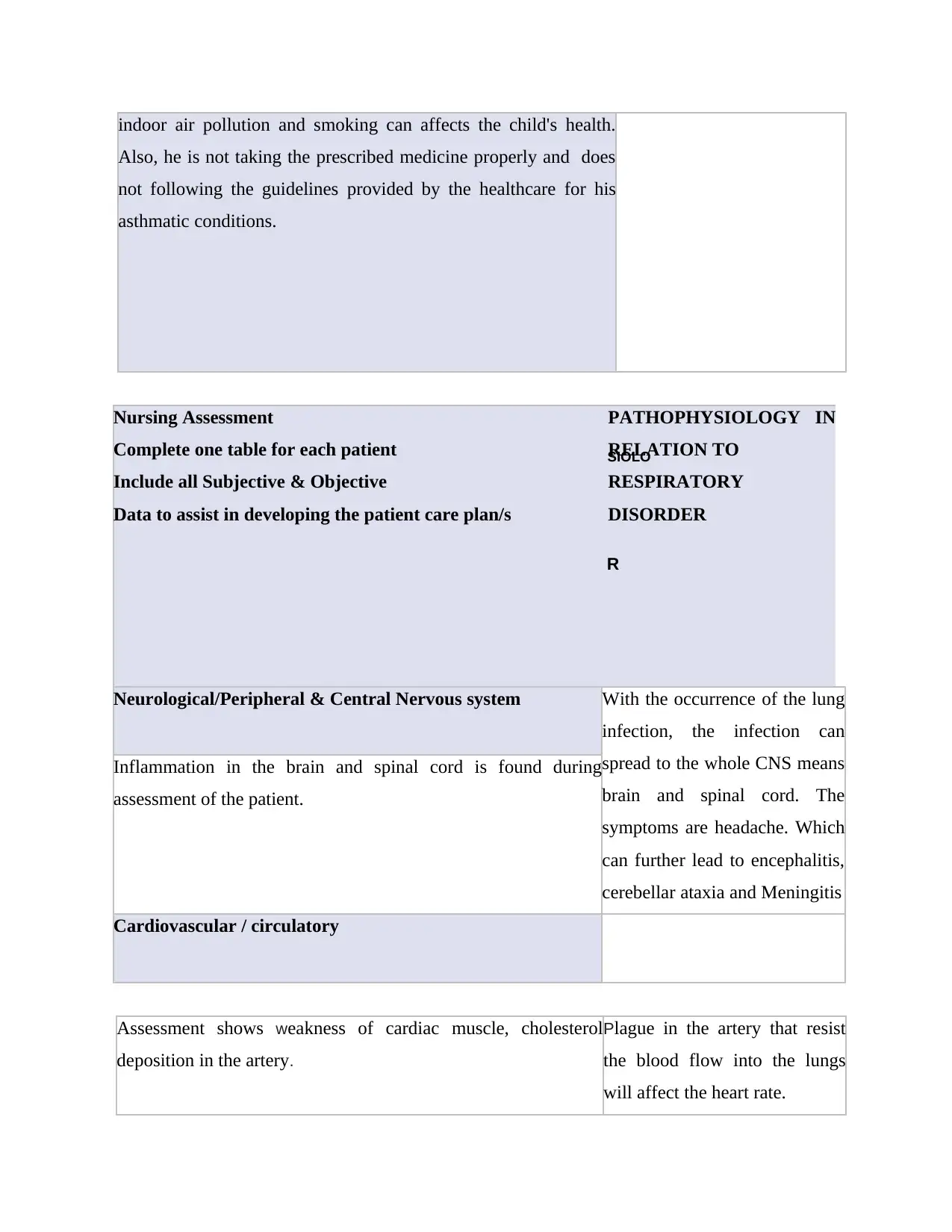
indoor air pollution and smoking can affects the child's health.
Also, he is not taking the prescribed medicine properly and does
not following the guidelines provided by the healthcare for his
asthmatic conditions.
Nursing Assessment
Complete one table for each patient
Include all Subjective & Objective
Data to assist in developing the patient care plan/s
SIOLO
R
PATHOPHYSIOLOGY IN
RELATION TO
RESPIRATORY
DISORDER
Neurological/Peripheral & Central Nervous system With the occurrence of the lung
infection, the infection can
spread to the whole CNS means
brain and spinal cord. The
symptoms are headache. Which
can further lead to encephalitis,
cerebellar ataxia and Meningitis
Inflammation in the brain and spinal cord is found during
assessment of the patient.
Cardiovascular / circulatory
Assessment shows weakness of cardiac muscle, cholesterol
deposition in the artery.
Plague in the artery that resist
the blood flow into the lungs
will affect the heart rate.
Also, he is not taking the prescribed medicine properly and does
not following the guidelines provided by the healthcare for his
asthmatic conditions.
Nursing Assessment
Complete one table for each patient
Include all Subjective & Objective
Data to assist in developing the patient care plan/s
SIOLO
R
PATHOPHYSIOLOGY IN
RELATION TO
RESPIRATORY
DISORDER
Neurological/Peripheral & Central Nervous system With the occurrence of the lung
infection, the infection can
spread to the whole CNS means
brain and spinal cord. The
symptoms are headache. Which
can further lead to encephalitis,
cerebellar ataxia and Meningitis
Inflammation in the brain and spinal cord is found during
assessment of the patient.
Cardiovascular / circulatory
Assessment shows weakness of cardiac muscle, cholesterol
deposition in the artery.
Plague in the artery that resist
the blood flow into the lungs
will affect the heart rate.
Paraphrase This Document
Need a fresh take? Get an instant paraphrase of this document with our AI Paraphraser
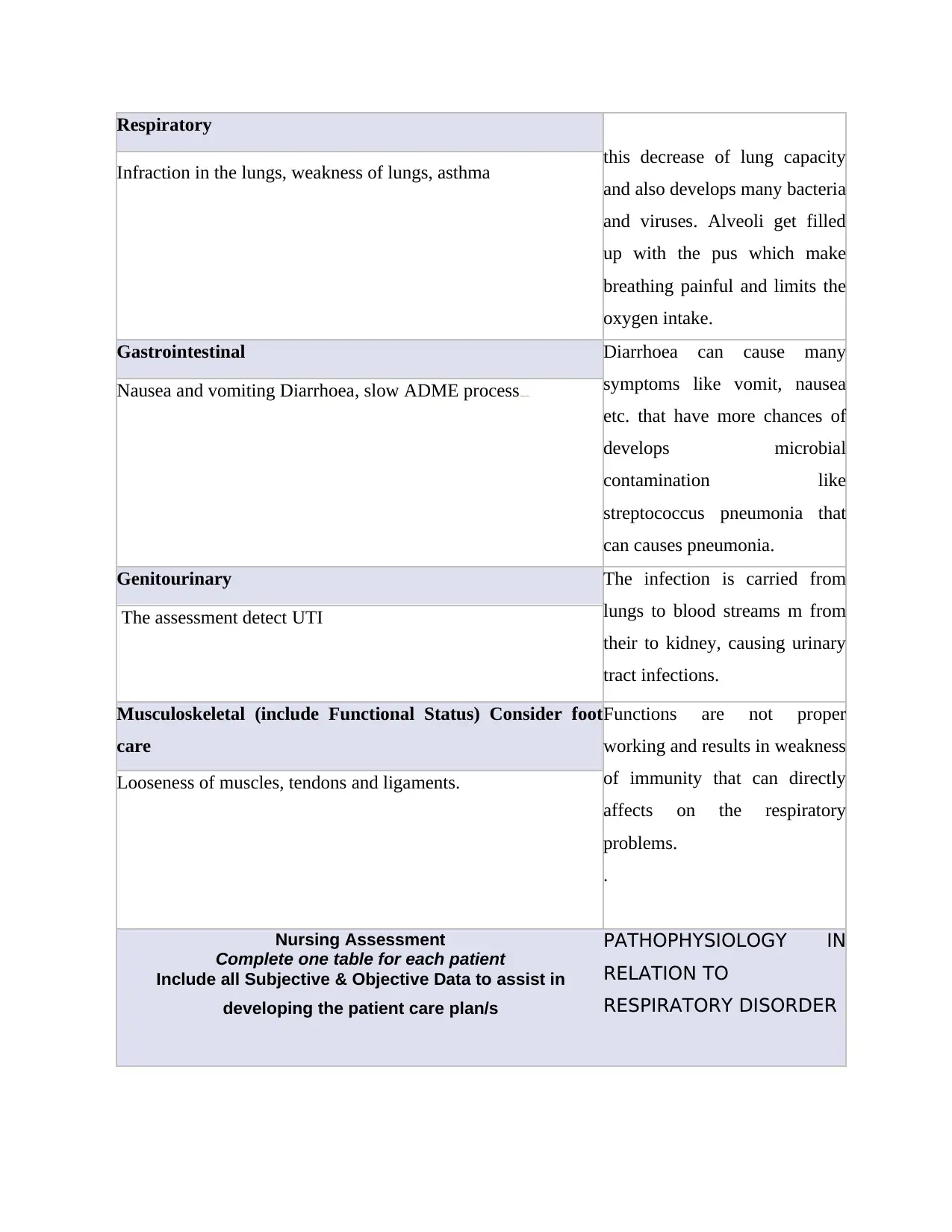
Respiratory
this decrease of lung capacity
and also develops many bacteria
and viruses. Alveoli get filled
up with the pus which make
breathing painful and limits the
oxygen intake.
Infraction in the lungs, weakness of lungs, asthma
Gastrointestinal Diarrhoea can cause many
symptoms like vomit, nausea
etc. that have more chances of
develops microbial
contamination like
streptococcus pneumonia that
can causes pneumonia.
Nausea and vomiting Diarrhoea, slow ADME process, Diarrhea, slow
Genitourinary The infection is carried from
lungs to blood streams m from
their to kidney, causing urinary
tract infections.
The assessment detect UTI
Musculoskeletal (include Functional Status) Consider foot
care
Functions are not proper
working and results in weakness
of immunity that can directly
affects on the respiratory
problems.
.
Looseness of muscles, tendons and ligaments.
Nursing Assessment
Complete one table for each patient
Include all Subjective & Objective Data to assist in
developing the patient care plan/s
PATHOPHYSIOLOGY IN
RELATION TO
RESPIRATORY DISORDER
this decrease of lung capacity
and also develops many bacteria
and viruses. Alveoli get filled
up with the pus which make
breathing painful and limits the
oxygen intake.
Infraction in the lungs, weakness of lungs, asthma
Gastrointestinal Diarrhoea can cause many
symptoms like vomit, nausea
etc. that have more chances of
develops microbial
contamination like
streptococcus pneumonia that
can causes pneumonia.
Nausea and vomiting Diarrhoea, slow ADME process, Diarrhea, slow
Genitourinary The infection is carried from
lungs to blood streams m from
their to kidney, causing urinary
tract infections.
The assessment detect UTI
Musculoskeletal (include Functional Status) Consider foot
care
Functions are not proper
working and results in weakness
of immunity that can directly
affects on the respiratory
problems.
.
Looseness of muscles, tendons and ligaments.
Nursing Assessment
Complete one table for each patient
Include all Subjective & Objective Data to assist in
developing the patient care plan/s
PATHOPHYSIOLOGY IN
RELATION TO
RESPIRATORY DISORDER
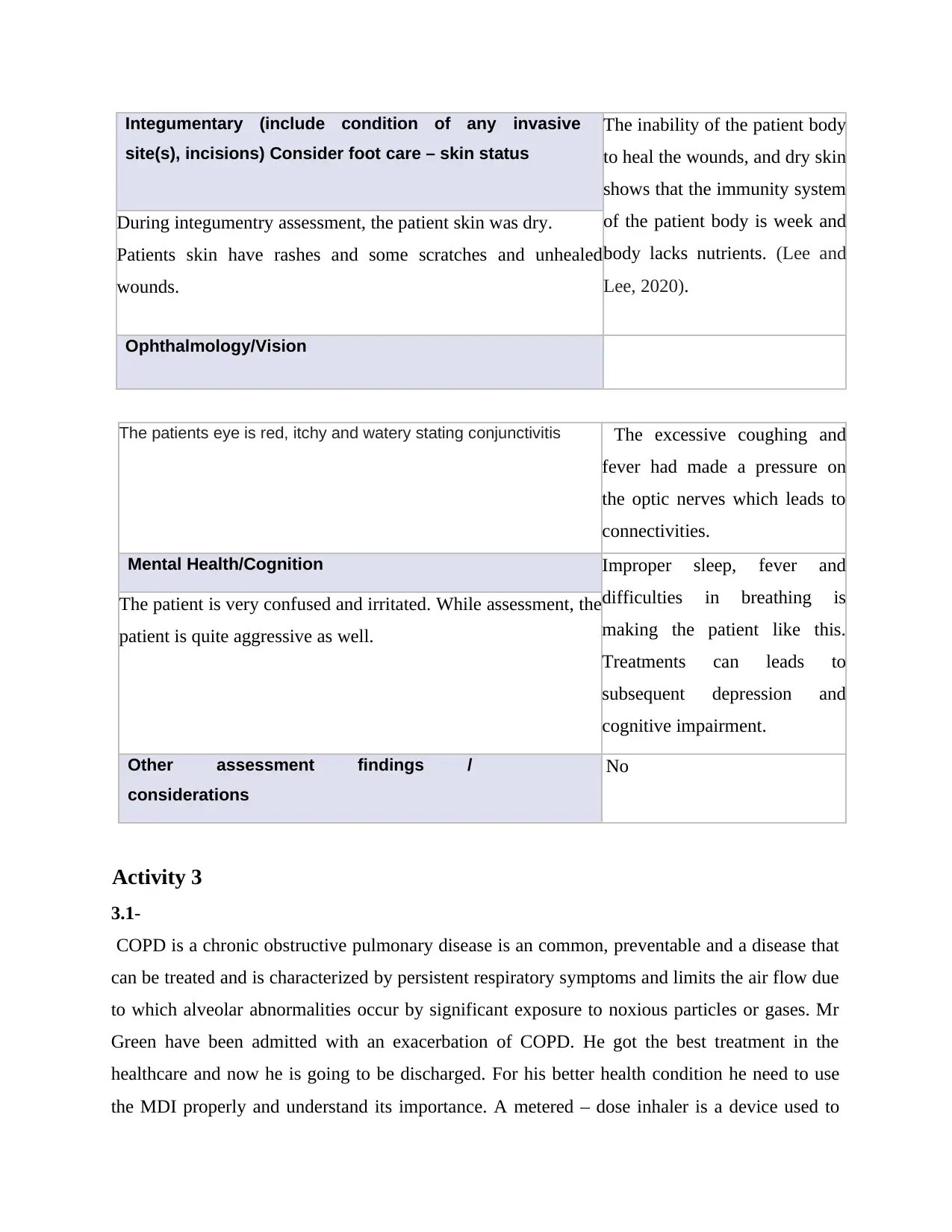
Integumentary (include condition of any invasive
site(s), incisions) Consider foot care – skin status
The inability of the patient body
to heal the wounds, and dry skin
shows that the immunity system
of the patient body is week and
body lacks nutrients. (Lee and
Lee, 2020).
During integumentry assessment, the patient skin was dry.
Patients skin have rashes and some scratches and unhealed
wounds.
Ophthalmology/Vision
The patients eye is red, itchy and watery stating conjunctivitis The excessive coughing and
fever had made a pressure on
the optic nerves which leads to
connectivities.
Mental Health/Cognition Improper sleep, fever and
difficulties in breathing is
making the patient like this.
Treatments can leads to
subsequent depression and
cognitive impairment.
The patient is very confused and irritated. While assessment, the
patient is quite aggressive as well.
Other assessment findings /
considerations
No
Activity 3
3.1-
COPD is a chronic obstructive pulmonary disease is an common, preventable and a disease that
can be treated and is characterized by persistent respiratory symptoms and limits the air flow due
to which alveolar abnormalities occur by significant exposure to noxious particles or gases. Mr
Green have been admitted with an exacerbation of COPD. He got the best treatment in the
healthcare and now he is going to be discharged. For his better health condition he need to use
the MDI properly and understand its importance. A metered – dose inhaler is a device used to
site(s), incisions) Consider foot care – skin status
The inability of the patient body
to heal the wounds, and dry skin
shows that the immunity system
of the patient body is week and
body lacks nutrients. (Lee and
Lee, 2020).
During integumentry assessment, the patient skin was dry.
Patients skin have rashes and some scratches and unhealed
wounds.
Ophthalmology/Vision
The patients eye is red, itchy and watery stating conjunctivitis The excessive coughing and
fever had made a pressure on
the optic nerves which leads to
connectivities.
Mental Health/Cognition Improper sleep, fever and
difficulties in breathing is
making the patient like this.
Treatments can leads to
subsequent depression and
cognitive impairment.
The patient is very confused and irritated. While assessment, the
patient is quite aggressive as well.
Other assessment findings /
considerations
No
Activity 3
3.1-
COPD is a chronic obstructive pulmonary disease is an common, preventable and a disease that
can be treated and is characterized by persistent respiratory symptoms and limits the air flow due
to which alveolar abnormalities occur by significant exposure to noxious particles or gases. Mr
Green have been admitted with an exacerbation of COPD. He got the best treatment in the
healthcare and now he is going to be discharged. For his better health condition he need to use
the MDI properly and understand its importance. A metered – dose inhaler is a device used to
⊘ This is a preview!⊘
Do you want full access?
Subscribe today to unlock all pages.

Trusted by 1+ million students worldwide
1 out of 29
Related Documents
Your All-in-One AI-Powered Toolkit for Academic Success.
+13062052269
info@desklib.com
Available 24*7 on WhatsApp / Email
![[object Object]](/_next/static/media/star-bottom.7253800d.svg)
Unlock your academic potential
Copyright © 2020–2025 A2Z Services. All Rights Reserved. Developed and managed by ZUCOL.





